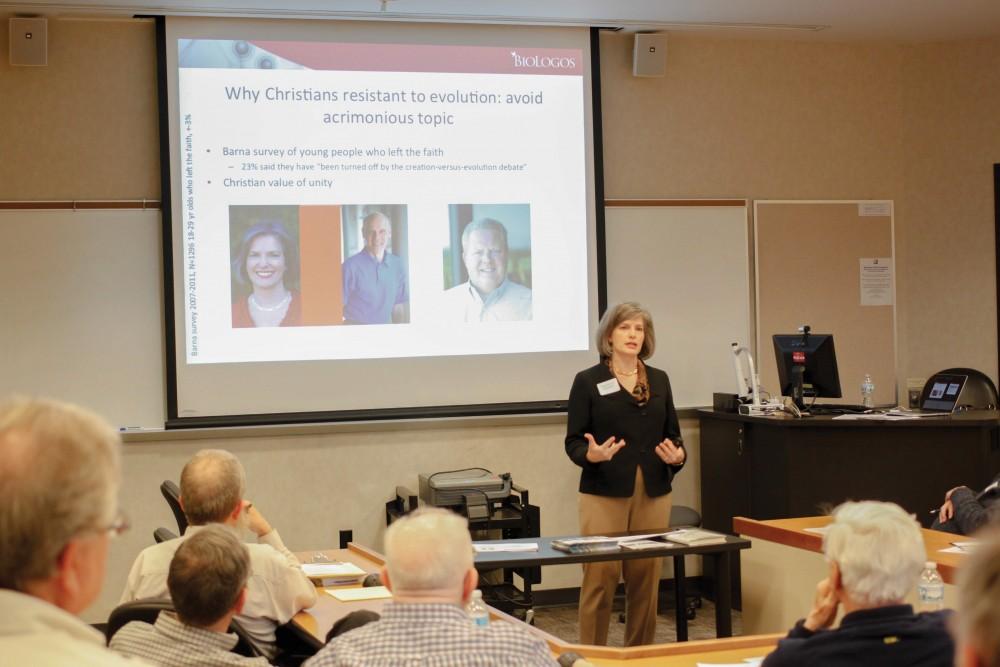Grand Dialogue discusses science and religion

GVL/Marissa Dillon
Apr 13, 2014
Alvin Plantinga presented his theory that naturalism and evolution are incompatible at the Grand Dialogue at Grand Valley State University on Saturday. The Grand Dialogue is meant to open conversation about the relationship between science and religion.
Plantinga is the John A. O’Brien Professor of Philosophy Emeritus at the University of Notre Dame. He said he believes that Christians can believe in evolution but cannot believe that evolution happens by accident. This is because one of the core Christian beliefs is the idea that God created human beings in his image.
“There is a science/religion — or science/quasi-religion — conflict, all right,” Plantinga said. “But it is a conflict between naturalism and science, not theistic religion and science.”
By the term “quasi-religion,” Plantinga is referring to naturalism, which he defined as the “thought that there is no such thing as the God of theistic religion or anything like him.” If both naturalism and the current evolutionary theory were true, Plantinga said, then the likelihood of reliable cognitive faculties, meaning memory and perception, would be low.
As an evolutionary biologist, GVSU biology professor Michael Lombardo responded to Plantinga, supporting the idea that naturalism is the best way to explain the observations and data recorded about the world. Lombardo said naturalism is superior because it is the only form of science that purely seeks answers through natural explanations, completely disregarding any form of the supernatural for things that happen in the natural world.
“Remember in science, ideas that are not testable are of little value to increasing knowledge and understanding,” Lombardo said. “In science, we require tangible evidence, not just arguments. In fact, theistic ideas about causes of life, especially in nature, are outside the domain of science. They’re not vulnerable to either testing or verification.”
Deborah Haarsma, an astronomer, Christian, and the president at BioLogos — a company that dedicates itself to dispelling the idea that science is in conflict with religion, said she believes that God created all matter and continually upholds his laws and creation. However, she also believes that natural evolution is entirely possible and has yet to see a miracle of direct divine intervention throughout her studies of the creation of galaxies.
“For me, doing science has enhanced my faith,” Haarsma said. “When I see the beauty of the natural world, I see God’s glory. When I see the fascinating processes and physics, I see God’s creativity.”
Haarsma took issue with Lombardo’s idea that having a presupposed idea of Christian belief is incompatible with scientific discovery. She said she disagrees with this idea because in history, many influential scientists were Christians and still made top discoveries.
“The regularity of nature is because of God’s faithful governance,” Haarsma said. “And it’s worth studying the natural world because it is God’s creation. We’re learning things about God from looking at his world.”
Several breakout sessions followed Plantinga’s keynote and the responses by Lombardo and Haarsma. They discussed a wide variety of topics surrounding the central idea of the conflicts between religion and science. Such topics included “What is natural selection?” by Lombardo, “What can the Talmuds tell us about science and medicine?” by GVSU professor Sheldon Kopperl, and “Humans are religious beings: An existential-functional account” by John Cooper, a professor of philosophical theology at Calvin Theological Seminary. Breakout session presenters came from local colleges, universities, seminaries and organizations.
“Here in Grand Dialogue, we have a lot of different faiths in the room,” Haarsma said. “But I think that we have a consensus that we are respectful to each other and also seem to be interested to consider how spirituality and science fit together, and maybe share disappointment and even grief that there are a lot of students out there who do not see that science and belief can fit together.”






















